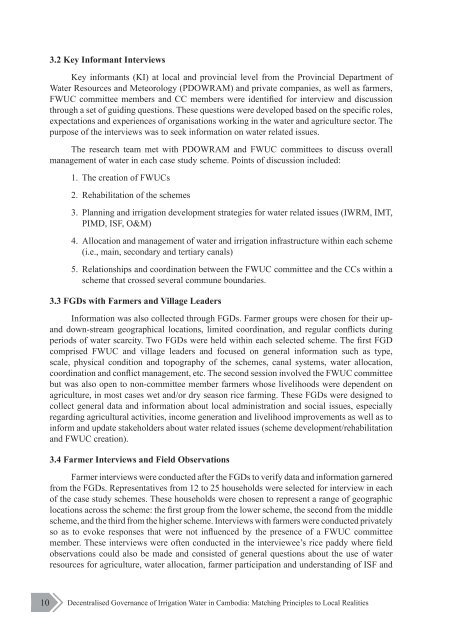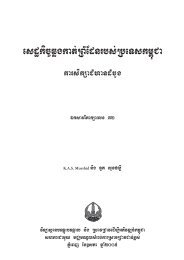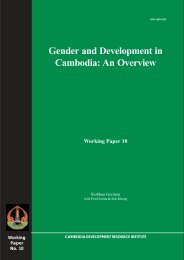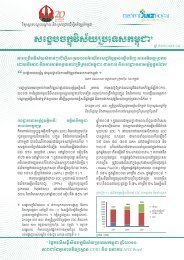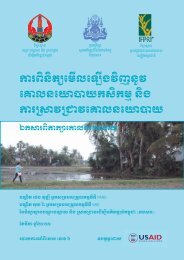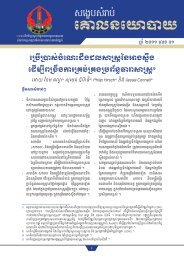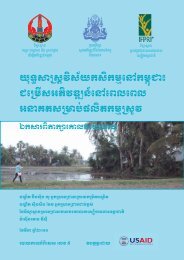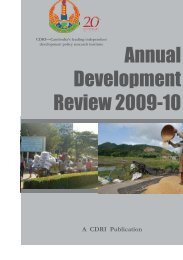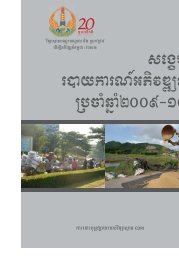62) decentralised governance of irrigation water in cambodia - CDRI
62) decentralised governance of irrigation water in cambodia - CDRI
62) decentralised governance of irrigation water in cambodia - CDRI
Create successful ePaper yourself
Turn your PDF publications into a flip-book with our unique Google optimized e-Paper software.
3.2 Key Informant Interviews<br />
Key <strong>in</strong>formants (KI) at local and prov<strong>in</strong>cial level from the Prov<strong>in</strong>cial Department <strong>of</strong><br />
Water Resources and Meteorology (PDOWRAM) and private companies, as well as farmers,<br />
FWUC committee members and CC members were identified for <strong>in</strong>terview and discussion<br />
through a set <strong>of</strong> guid<strong>in</strong>g questions. These questions were developed based on the specific roles,<br />
expectations and experiences <strong>of</strong> organisations work<strong>in</strong>g <strong>in</strong> the <strong>water</strong> and agriculture sector. The<br />
purpose <strong>of</strong> the <strong>in</strong>terviews was to seek <strong>in</strong>formation on <strong>water</strong> related issues.<br />
The research team met with PDOWRAM and FWUC committees to discuss overall<br />
management <strong>of</strong> <strong>water</strong> <strong>in</strong> each case study scheme. Po<strong>in</strong>ts <strong>of</strong> discussion <strong>in</strong>cluded:<br />
1.<br />
2.<br />
The creation <strong>of</strong> FWUCs<br />
Rehabilitation <strong>of</strong> the schemes<br />
3. Plann<strong>in</strong>g and <strong>irrigation</strong> development strategies for <strong>water</strong> related issues (IWRM, IMT,<br />
PIMD, ISF, O&M)<br />
4. Allocation and management <strong>of</strong> <strong>water</strong> and <strong>irrigation</strong> <strong>in</strong>frastructure with<strong>in</strong> each scheme<br />
(i.e., ma<strong>in</strong>, secondary and tertiary canals)<br />
5. Relationships and coord<strong>in</strong>ation between the FWUC committee and the CCs with<strong>in</strong> a<br />
scheme that crossed several commune boundaries.<br />
3.3 FGDs with Farmers and Village Leaders<br />
Information was also collected through FGDs. Farmer groups were chosen for their up-<br />
and down-stream geographical locations, limited coord<strong>in</strong>ation, and regular conflicts dur<strong>in</strong>g<br />
periods <strong>of</strong> <strong>water</strong> scarcity. Two FGDs were held with<strong>in</strong> each selected scheme. The first FGD<br />
comprised FWUC and village leaders and focused on general <strong>in</strong>formation such as type,<br />
scale, physical condition and topography <strong>of</strong> the schemes, canal systems, <strong>water</strong> allocation,<br />
coord<strong>in</strong>ation and conflict management, etc. The second session <strong>in</strong>volved the FWUC committee<br />
but was also open to non-committee member farmers whose livelihoods were dependent on<br />
agriculture, <strong>in</strong> most cases wet and/or dry season rice farm<strong>in</strong>g. These FGDs were designed to<br />
collect general data and <strong>in</strong>formation about local adm<strong>in</strong>istration and social issues, especially<br />
regard<strong>in</strong>g agricultural activities, <strong>in</strong>come generation and livelihood improvements as well as to<br />
<strong>in</strong>form and update stakeholders about <strong>water</strong> related issues (scheme development/rehabilitation<br />
and FWUC creation).<br />
3.4 Farmer Interviews and Field Observations<br />
Farmer <strong>in</strong>terviews were conducted after the FGDs to verify data and <strong>in</strong>formation garnered<br />
from the FGDs. Representatives from 12 to 25 households were selected for <strong>in</strong>terview <strong>in</strong> each<br />
<strong>of</strong> the case study schemes. These households were chosen to represent a range <strong>of</strong> geographic<br />
locations across the scheme: the first group from the lower scheme, the second from the middle<br />
scheme, and the third from the higher scheme. Interviews with farmers were conducted privately<br />
so as to evoke responses that were not <strong>in</strong>fluenced by the presence <strong>of</strong> a FWUC committee<br />
member. These <strong>in</strong>terviews were <strong>of</strong>ten conducted <strong>in</strong> the <strong>in</strong>terviewee’s rice paddy where field<br />
observations could also be made and consisted <strong>of</strong> general questions about the use <strong>of</strong> <strong>water</strong><br />
resources for agriculture, <strong>water</strong> allocation, farmer participation and understand<strong>in</strong>g <strong>of</strong> ISF and<br />
10 Decentralised Governance <strong>of</strong> Irrigation Water <strong>in</strong> Cambodia: Match<strong>in</strong>g Pr<strong>in</strong>ciples to Local Realities


